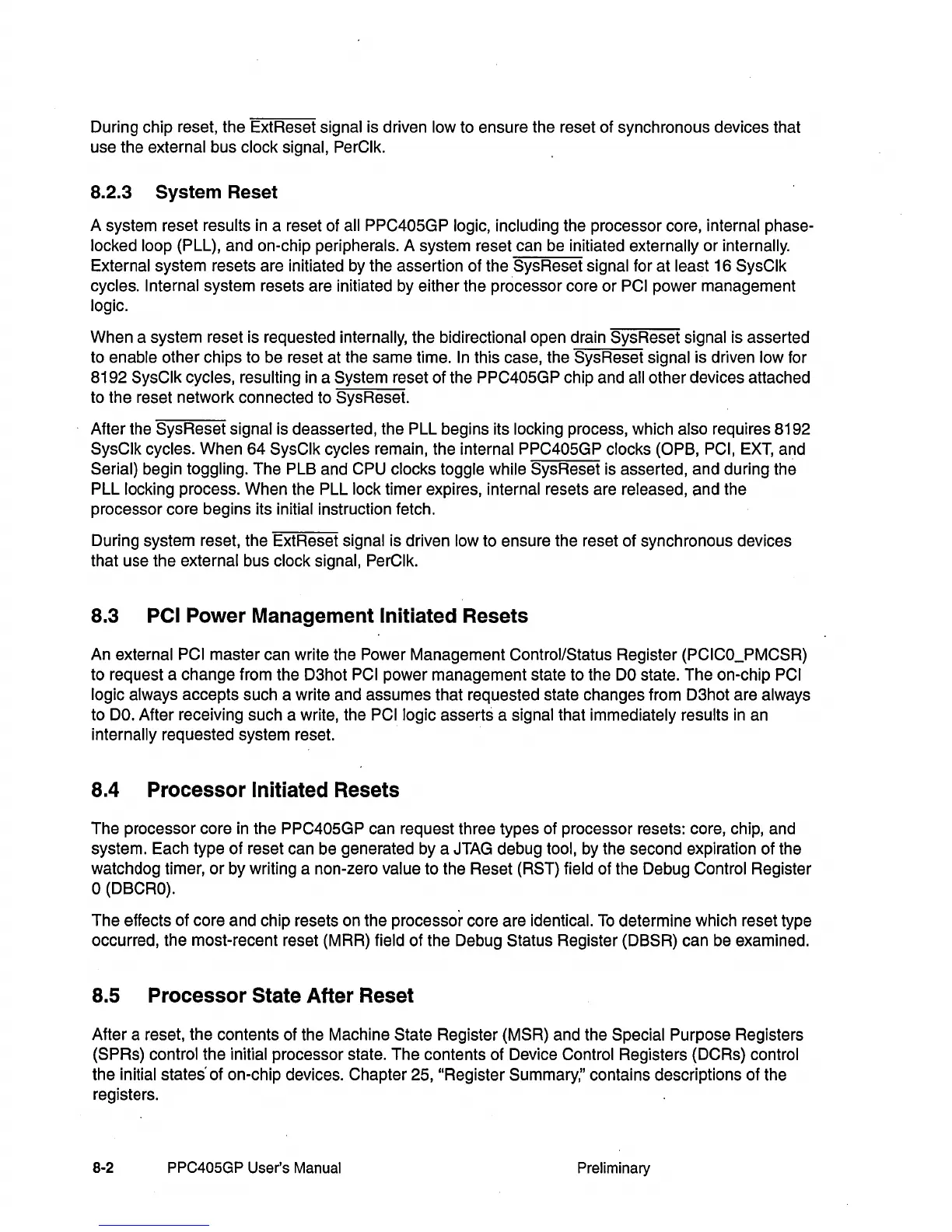During chip
reset,
the
ExtReset signal
is
driven
low
to
ensure
the
reset
of
synchronous devices that
use
the
external
bus
clock signal,
PerClk.
8.2.3 System Reset
A
system
reset results
in
a
reset
of
all
PPC405GP
logic,
including
the
processor
core,
internal
phase-
locked
loop
(PLL),
and
on-chip peripherals. A
system
reset
can
be
initiated externally
or
internally.
External system resets
are
initiated
by
the
assertion of
the
SysReset signal
for
at least
16
SysClk
cycles.
Internal
system
resets
are
initiated
by
either
the
processor
core
or
PCI
power management
logic.
When
a system
reset
is
requested
internally,
the
bidirectional
open
drain
SysReset signal
is
asserted
to
enable
other chips
to
be
reset
at
the
same
time.
In
this
case,
the
SysReset signal
is
driven
low
for
8192
SysClk
cycles,
resulting
in
a
System
reset
of
the
PPC405GP
chip
and
all
other devices attached
to
the
reset
network connected
to
SysReset.
After
the
SysReset signal
is
deasserted,
the
PLL
begins
its
locking
process,
which
also
requires
8192
SysClk cycles.
When
64
SysClk cycles
remain,
the
internal
PPC405GP
clocks
(OPS,
PCI,
EXT,
and
Serial)
begin
toggling.
The
PLS
and
CPU
clocks
toggle
while SysReset
is
asserted,
and
during
the
PLL
locking
process.
When
the
PLL
lock timer
expires,
internal
resets
are
released,
and
the
processor
core
begins its initial instruction
fetch.
During
system
reset,
the
ExtReset
signal
is
driven
low
to
ensure
the
reset
of synchronous devices
that
use
the
external
bus
clock
signal,
PerClk.
8.3
pel
Power Management Initiated Resets
An
external
PCI
master
can
write
the
Power
Management Control/Status Register
(PCICO_PMCSR)
to
request a change
from
the
D3hot
PCI
power management
state
to
the
DO
state.
The
on-chip
PCI
logic
always
accepts
such
a write
and
assumes that requested
state
changes
from
D3hot
are
always
to
DO.
After receiving
such
a
write,
the
PCI
logic asserts a signal that immediately results
in
an
internally requested
system
reset.
8.4 Processor Initiated Resets
The
processor
core
in
the
PPC405GP
can
request three types
of
processor
resets:
core,
chip,
and
system.
Each
type of reset
can
be
generated
by
a
JTAG
debug
tool,
by
the
second
expiration of
the
watchdog
timer,
or
by
writing a
non-zero
value
to
the
Reset
(RST)
field
of
the
Debug
Control Register
o
(DBCRO).
The
effects of
core
and
chip
resets
on
the
processor
core
are
identical.
To
determine
which
reset
type
occurred,
the
most-recent
reset
(MRR)
field
of
the
Debug
Status Register
(DSSR)
can
be
examined.
8.5 Processor State After Reset
After a
reset,
the
contents
of
the
Machine
State Register
(MSR)
and
the
Special Purpose Registers
(SPRs)
control
the
initial processor
state.
The
contents
of
Device
Control
Registers
(DCRs)
control
the
initial states'
of
on-chip
devices.
Chapter
25,
"Register
Summary,"
contains descriptions of
the
registers.
8-2 PPC405GP User's Manual
Preliminary

